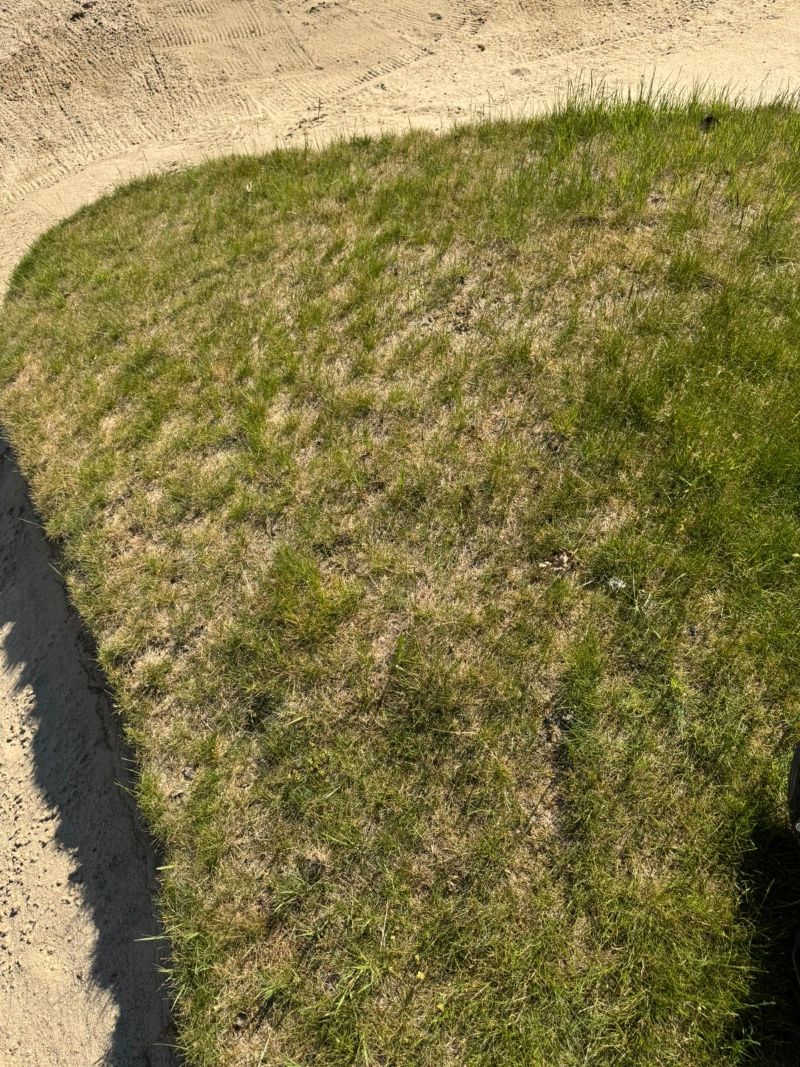- Homepage
- News and Features
- UK Greenkeepers on the prolonged lack of rainfall this spring: “It’s very, very dry.”
UK Greenkeepers on the prolonged lack of rainfall this spring: “It’s very, very dry.”
The UK is experiencing its driest spring since the Second World War – and the impact is unsurprisingly being felt at every single golf course.

“I heard on the radio they’re already talking about hosepipe bans in the south-east because of the drought,” said David Byron, Head Greenkeeper at Essex’s Thorndon Park. “If this continues, it’s going to be a tough summer.”
Look out of your window and what do you see? Most likely, bright sunshine and blue skies. It’s manna from heaven for sunseekers. But it’s a problem for anyone who manages turf. To say we’ve experienced some weather extremes over the past couple of years is an understatement.
April 2024 was one of the wettest in nearly two centuries. Fast forward 12 months and, according to the Met Office, the UK recorded just over half the average rainfall it would expect to see in a normal month. That has been a trend in 2025. “Wales saw its fourth driest March on record, its driest since 1944,” said the meteorological body’s regular four-weekly summary. “Suffolk and Norfolk experienced their second driest Marches on record, with only March 1929 drier.”
May is also shaping up to be parched – with warm temperatures, lots of sun, and barely a raincloud in sight. It’s a huge concern for greenkeepers up and down Great Britain and Ireland.

“It’s very, very dry,” explained David. “It’s the driest start to spring in nearly 70 years. We’ve had almost no rain, and what we have had has come in just one hit, so it’s not consistent. I was out measuring moisture in our fairways and we’re down to about 3-4% moisture content. Normally, you’d want 10 to 15% moisture content for the grass species we have.”
Like so many turf managers, Richard Johnstone, Course Manager at Royal Aberdeen, meticulously takes down rainfall figures. There were just nine millimetres there in April. So far in May, there has only been two. In the five months from October last year to February 2025, there was 300mm less rainfall than in the equivalent period between 2023 and 2024. “We’re experiencing extreme weather patterns now,” he said. “There’s no longer a balance. Instead, we’re seeing one extreme or the other – either constant pouring rain or complete drought. “There doesn’t seem to be much consistency anymore, and that presents some big challenges.”
“As course managers, it’s our responsibility to communicate and educate both our membership and visiting parties. We need to use various channels like social media, blogs, and other platforms to help people understand the current conditions and our management approach.”
Richard Johnstone, Royal Aberdeen Course Manager
What is the problem, you might ask? Following two of the wettest winters the UK has seen in decades, surely a period of sun is just what the golf course doctor ordered? But we’ve gone from worm casts and mud to cold dry mornings, sun shear, and not a hint of precipitation. Turf just can’t recover. “We’re essentially no better off than we were at the peak of winter, despite it being drier,” said David. “Obviously, areas with fairway irrigation are faring better. We can control areas like greens, aprons, surrounds, and tees with irrigation, which are doing well. But we’re burning through water quickly to maintain them, and we’re going through our water allowance much earlier in the year.”
What are course managers up against? Paul Woodham is The R&A’s Agronomy Lead for Europe and the UK. He is a global turf expert and a key part of the governing body’s sustainability team. “The lack of rainfall combined with warm days and cold nighttime temperature has caused issues for greenkeepers across the British Isles,” he said. “The impact is seen in a lack of recovery from winter wear and is particularly challenging in situations for courses which suffered winter disease scarring and damage caused by leatherjacket larvae. Greenkeepers have seen the early onset of turfgrass stress, especially with Poa annua being stunted coming into the seasonal emergence of seed heads in mid-May.
“These combined stresses have made it difficult for greenkeepers managing the transition through spring and seeking surface refinement for main season performance. The fluctuation in unpredictable and extreme climatic conditions appears to be a seasonal norm testing the patience of the golfer."
At Royal Aberdeen, in the north-east of Scotland, they’re shifting 27mm of water a week through evapotranspiration. That’s the process where water is lost from plants and the soil – transferred from the land to the atmosphere. They’re cutting the greens sparingly – only twice last week, otherwise rolling them to keep them smooth and true. “The key is not stressing out the surfaces,” Richard said. “We’re focusing on areas that look stressed by applying wetting agents and irrigating. Since we have an irrigation system, we can help retain moisture. The goal is to prevent the surfaces from becoming hydrophobic, where the soil starts repelling water. If that happens, you can start losing turf. We’re trying to stop the surfaces from reaching that critical stage.”
“Our advice to clubs is to engage in professional dialogue with your Course Manager, set agreed objectives and show open support for your team of greenkeepers”
Jim Croxton, BIGGA CEO
At Thorndon Park, they’re applying deep soaks to encourage roots to grow deeper. They’re also looking at traffic management to try and ease areas that might suffer from wear and tear. David said: “You don’t want to be creating a shallow root situation by over-watering, which is tempting and easy to do. You just want to give it a deep soak and let the grass fend for itself a bit. You’ve almost got to keep it right on the edge, otherwise you’re going to run out of water quickly.”
He added: “We’ve put out a lot of rope for traffic management, which we’d normally do in winter, but it’s just to prevent areas being worn down. We’ve applied a plant growth regulator and held back on feeds because the plant is almost dormant. Anything you’re putting on to try and push growth or encourage it, it doesn’t want to use it, so there’s no point. We haven’t been mowing much because all you’re doing is polishing the surface. We’ll mow greens regularly, but for fairways and semi-roughs, we’re only mowing about once a week. There’s no point in doing more – you’ll just make the problem worse and cause unnecessary wear.”

Ropes in spring? Fairways that are browning? It’s not what golfers expect. We think the course should be looking its best right now. But we’ve got to understand our desires are unattainable and then play our part in making things easier for our greenkeepers as they battle the conditions.
“Greenkeepers go to work every day with the intention of providing the best conditions possible,” said Scott Reeves, BIGGA Head of Membership.
“Some of the factors that determine this are within their power, using workforce, resources and inventory in a planned and considered fashion.
“Sometimes success is not always determined by things they can control, and the weather is an obvious example of this. If drought, flood or temperatures affect the quality of playing conditions they may not be able to provide optimum quality turf.
“At BIGGA we work with professional greenkeepers every day and we regularly hear about their challenges which, often, they can overcome successfully. Unfortunately, at times this is not the case, and an experienced Course Manager is subject to harsh and unfair criticism from club members. We urge you to have faith in your professional course management team; they probably share your concerns and are working hard behind the scenes to provide you with the playing conditions to which you aspire.”
“Some golfers around the country understand there’s no rain and it’s dry, but they somehow can’t connect why the golf course isn’t improving,” explained Thorndon Park’s David Byron. “They’ll say, ‘it’s May, so everything should be fine’, but they don’t grasp that the lack of rain is precisely why nothing is recovering. Most of them do understand, but greenkeepers have to constantly communicate and explain the situation to help the penny drop in some cases.”
Richard added: “As course managers, it’s our responsibility to communicate and educate both our membership and visiting parties. “We need to use various channels like social media, blogs, and other platforms to help people understand the current conditions and our management approach.”
With the weather set to stay firm for the next couple of weeks, the pressures on course teams will build. Rain will come as a blessed relief. But we haven’t reached summer yet, and scorching temperatures in July and August will only exacerbate the issue for courses still recovering from a hot spring and a difficult winter.
At Royal Aberdeen, wall-to-wall irrigation on the Championship course will see them through this spell, while two boreholes mean they’re not short of water. But there are two layouts at the Highlands venue. “Our strategy will be managing how and when we cut surfaces,” said Richard. “We may not cut as much as we normally would. Some areas on the non-irrigated course will be out of our control, and we’ll have to see what happens to them.”
For Thorndon Park, meanwhile, the impact of weeks of no rain may still be evident months down the line. David said: “Normally, early recovery happens up until the end of May, when the golf course is primed and ready for the peak season. This year, we’re starting on the back foot, essentially doubling down on wear and tear from winter and early spring, with no growth or recovery. “By peak season, unless we get significant rain in July and July, we’ll be behind. Without a good autumn, where we can push recovery, we’ll be going into winter at a disadvantage. Greens and other irrigated areas will probably be OK, but non-irrigated areas like fairways will suffer. The positive side is that when it’s dry and firm, golfers can still play. It’s much harder to play when the course is flooded. The main impact will be on the course’s visual presentation and condition.”

Managing expectations is key. That and giving hardworking greenkeepers a break. On behalf of its members, BIGGA is asking golfers to stay patient.
“Golf club members and visitors are used to seeing green playing surfaces and it is important we develop an understanding that under the current circumstances, this is quite simply not possible. We need to ask our members and visiting golfers to be considerate of this,” said Chief Executive Jim Croxton. Our advice to clubs is to engage in professional dialogue with your Course Manager, set agreed objectives and show open support for your team of greenkeepers. They will be much more motivated and determined to overcome these challenges with strong support from their members.”
Author

